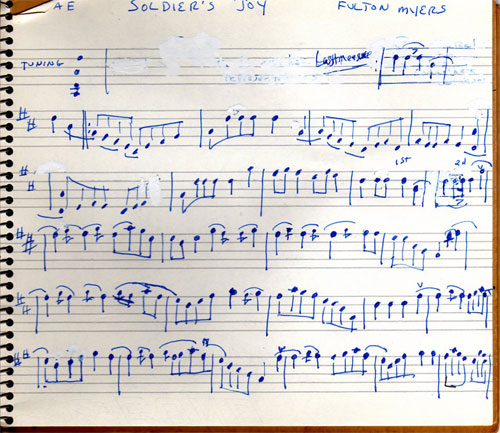Sidna & Fulton Myers (FRC504)
by Jody Stecher (Fiddler Magazine)
This installment of Cross-Tuning Workshop (CROSS-TUNING WORKSHOP Part Thirty-Two: ADAE) pairs a well-known fiddle tune with a little-known but fascinating fiddler. “Soldier’s Joy” is a contender for the world’s most played fiddle tune. If you wonder why, you’ve heard only the bad versions. This is a great tune for dancing, always fun to play (on any instrument), and it carries a huge amount of energy which it will release to almost any willing fiddler. It has also been much discussed in print and on the internet. To the debate I will add only that I agree with the faction that posits a Scandinavian provenance to the tune and that it seems to me that two of the alternate titles, “Payday In The Army” and “The King’s Head” are paraphrasing the concept of a soldier’s joy. Historically, a king’s head was depicted on a coin, and a soldier was rarely paid on time. Hey, I actually got paid this time!
Printed versions of “Soldier’s Joy” are found as early as the mid eighteenth century and it seems the tune is older than that. The most intriguing version I have heard was played by Fulton Myers, a modest man from Five Forks, Virginia, a little place not far from Galax and Hillsville.
Everyone who has written about him says the same thing, that he lived simply and had no electricity. I would have hoped to know more, that he’s a unique fiddler and worthy of discussion and attention. All the recordings of Fulton Myers and all the descriptions of his music pair him with his brother Sidna (pronounced Sidney), who is one of the most creative old-time banjo players I have heard. Recently the Field Recorders Collective has issued a CD of the Myers brothers (FRC504) which was recorded in the 1960s. For those who are familiar with what has become known (for better or worse) as the Round Peak repertoire, hearing it will be a real revelation as this music is so similar yet so very different.
Fulton Myers’ ornamentation of the second part of the tune would be commonplace anywhere between Bulgaria and Rajastan but I’ve never heard another Appalachian fiddler play this kind of grace note nor integrate bowing and ornamentation in quite this way. Sidna’s banjo playing occasionally had an exotic tinge as well. Could these brothers have been Gypsies? Did they indulge in listening binges to Radio Ankara on a short wave radio? Were they aliens from a parallel universe?
You will not find the answers to these questions at http://www.fieldrecorder.com/ but by all means visit the website of this remarkable group of people. The Field Recorders’ Collective has been doing everything right. They are making privately held recordings of fantastic traditional musicians available to the public, packaging them nicely, paying the musicians’ families money and paying them respect as well; and instead of printing detailed liner notes in microscopic letters, they are posting such details on the website.
I’m guessing at some of the bowing in the transcription. The banjo and fiddle are pretty well intertwangogrified on this recording and it’s hard to tell what’s what in places. This rendition of “Soldier’s Joy” is one of those cases where cross-tuning is used to affect timbre but does not affect fingering. The bass string is tuned to A but is never actually bowed. By all means bow it if you want.

